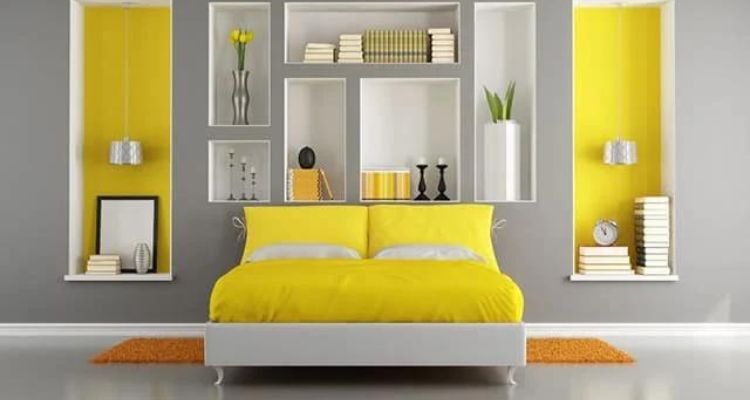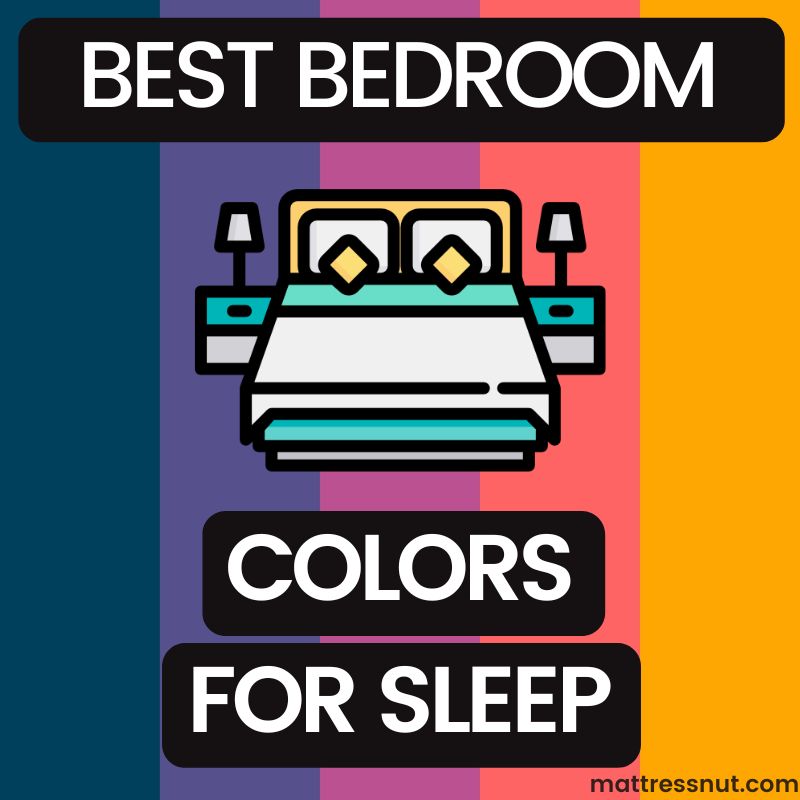Your bedroom is your place to take some rest. After a long, tiresome day of work, this is where you lie down, get some well-deserved rest, and sleep.
If your bedroom is too much energy oozing out of it, you will have trouble sleeping here, at least in the long run, unless you are extremely tired and can’t afford to skip a shut-eye session.
Therefore, the color you paint your bedroom with can directly impact how your mind and body rest. You need to paint it with the right colors that are more relaxing for your senses.
This guide will help you determine the best color for your bedroom. One that doesn’t look odd and gets you a good night’s sleep.
Science Behind Bedroom Color Schemes
Before we begin our discussion, you need to understand the science behind these colors. These colors can directly impact your ability to sleep. When you are more relaxed, and your senses are calm, you will fall asleep much more quickly.

The colors in your bedroom can make a difference between the night you sleep and the wine you toss and turn.
According to color psychologists, these hues tend to put us in different moods. Of course, the more relaxing tones are better for relaxing our moods and senses. These colors directly impact our circadian rhythm.
Why Does Color Choice Matter for Sleep?
Colors impact our moods and senses the same way different types of light do. You might have heard it is better to avoid brighter lights before bed because some colors disrupt sleep.
The human body has natural sleep-wake cycles. These cycles are under the control of the melatonin hormone. Human eyes have special photoreceptors that send information back to the brain and can directly influence melatonin production in the body.
A study in 2017 found that these photoreceptors are highly sensitive to lights with wavelengths ranging from 450 nm to 480 nm. To most people, this wavelength of light gives off a blue shade.
There is plenty of room for more research on other colors of light that can directly impact our sleep cycles. But studies have found that warmer colors tend to put you to sleep much more quickly than cooler colors.
Best Colors in Your Bedroom for Sleep
The best colors to have in your room so you can sleep quickly are white, pink, silver, green, yellow, and blue. These colors tend to relax your mind and ease your stress.
You can stick to more neutral or pastel shades for a welcoming and softer environment that invites you to calm down and sleep.
Blue is Cool & the Best Color for Sleep
Blue is the best color you can use in your bedroom. The reason for that is blue is commonly associated with relaxation and calmness.
This is a non-stimulating hue; in comparison, your brain is much more stimulated by red. So, the latter is not the right option for you to have in your bedroom.
But what do we mean here by a stimulated brain?
A highly stimulated brain produces more cortisol, resulting in lower sleep quality. Therefore, red is not the ideal color to have in your bedroom. You might be inclined to have red in your bedroom for love and romance, but it will not help you much with sleep.
Therefore, you need to have a blue color in your bedroom which is more relaxing. It is because your brain is more perceptive about this color due to the special receptors known as ganglion cells.
These cells are present in your retinas, and they collect info from your visual surroundings and translate it into chemical signals to a part of your brain called the hypothalamus. This part is responsible for producing hormones such as cortisol and melatonin.
When exposed to blue color, your brain will produce more melatonin and less cortisol. As a result, you will fall asleep much faster.
Yellow is happy

Yellow is another good option to have in your bedroom. But make sure you go for the softer shades. Such shades can tranquil your bedroom environment as the muted tones of this hue resemble sunshine.
Softer tones of yellow can alleviate stress and ease your senses down. Therefore, you will be able to fall asleep much more easily. The brighter tones of this color can boost your energy, and you must avoid them in your bedroom.
It is best to go for pastel tones of yellow colors that tend to be creamy. For instance, ivory color is a pretty good choice for this purpose. It’s a faded yellow color with a sense of relaxation.
Green is Organic
Another excellent option you can consider here is green. It’s an easy color on the eyes, just like blue. Human eyes are sensitive to green color as well.
You will feel much more relaxed in a painted green room. This is because green is a non-stimulant. But the best green color you can use for sleep must have blue tones.
You will feel more energetic if you have warmer tones of yellow in green. The rule of thumb here is to go for pastel shades if you want more soothing tones. So, pastel green will work for you the best.
Silver is Peaceful
If you prefer to go for neutral colors, then you must consider going for silver. However, be sure not to go for the darker tones that have more gray in them.
Silver calms your feelings down and puts you in a more relaxed mood. Make sure you go for a matte silver hue instead of the shiny one.
The shiny variant can reflect light and make your room brighter, preventing you from falling asleep faster. Your best choice is to go for a hue that is a lighter shade of gray. You can pair it with a light blue hue for a beautiful contrast.
Orange is Warm
Another option you can consider here is orange or light brown. You can go for beige or tan. These warmer tones resemble a sandy beach which has a relaxing effect on your brain.
You can choose orange with different undertones of brown. For example, a good option here is terracotta. Be sure to avoid any brighter tones because they invigorate your brain.
The brighter tones of orange have a similar effect to the red color, which is highly stimulating for your brain. Remember that softness is important, especially when picking a color for your bedroom.
Pink is Soft
You might think that pink is not ideal for your bedroom because it is a lighter shade of red. However, considering softer pink tones, this color can trigger some tranquil feelings.
Be sure not to go for any brighter tones of pink, as it will make your bedroom walls pop. This is not what you are looking for here. Cooler tones of pink will work the best as your walls will fade well into the background and help your mind to unwind.
Pink is available in various shades, from pale pink to gentle rosy pinks. Some are pretty close to white, and all work well in your bedroom.
White is Mild
Most people have white bedroom walls, and if you are one of them, you don’t need to change them. White is a simple color, and it has neutral characteristics.
It doesn’t have any features to cause distractions or boost your senses. However, some people might find white to be sterile and cold.
If you are among the people who find white pretty boring, you can always go for an accented wall and make a contract with some other soothing colors that we have mentioned above. After all, white goes pretty well with almost anything.
In your bedroom, you can have white walls and other pastel tones. Your bedroom will give you a more relaxed feeling. You can make your room slightly warmer if you use off-white or cream tones that look almost pale yellow.
Tips for Choosing Soothing Colors for Sleep
Here are some important tips to consider when you want to paint your bedroom walls using relaxing colors for a more calming environment.
Choosing the right color scheme
You must decide on an appropriate color scheme for your bedroom. You don’t want any hues clashing with one another. Go for the ones that align with one another.
Contrasting colors are always stimulating as they tend to clash with one another. You will feel more energetic or anxious instead of calm and relaxed. This happens mostly when one of your walls has accents in it.
We have mentioned that these accented walls must have white, but generally, it should be relaxing. Pastel shades always work the best. Any flashy or bright colors would be kept aside for other rooms. You can use them in your living room or kitchen.
Keep in mind what will be the color of your bedding. Those sheets, duvet covers, blankets, pillow shams, and pillowcases are pretty convenient to switch. So, your bedroom wall color should go well with any color of your bedding accessories.
Flat paint
Stick with flat paint, and don’t go for glossy or high-shines tones. Light will reflect from the shine or gloss of your paint, and it will cause sleep disruption.
Flatter paints have a matte finish, and they absorb light batter. Therefore, these tones are less invigorating and boost relaxation and calmness.
Some other ways to make your bedroom more relaxing
If you want to improve your overall sleep hygiene, you have to set up your bedroom correctly. There are a few tricks you can use apart from using different colors in your bedroom.
- Make your bedroom darker, especially when it’s time to sleep. If the light is sleeping through from the window into the room or from anywhere else, you might have trouble sleeping. You can use blackout curtains for that.
- Make sure you get all your technology out of your bedroom. Your TVs, computers, and tablets shouldn’t be in your bedroom. Don’t use your phone when you are about to get a shuteye.
- If possible, try to use your bedroom the least during the day. For instance, don’t take your laptop and sit in your bed if you work from home. Just keep your bedroom for lull time.
- Get a more relaxing mattress and bedding accessories that help you relax in your bed. This will enable you to go to sleep faster, and you will spend less time tossing and turning (check the most comfy mattresses).
Best Bedroom Colors For Sleep – Key Takeaways
Science Behind Bedroom Color Schemes
The choice of bedroom color can significantly impact your ability to sleep. Colors have the power to affect your mood and circadian rhythm. Understanding the science behind these colors is crucial for better sleep.
Why Does Color Choice Matter for Sleep?
Colors can influence your sleep-wake cycles by affecting the production of the sleep-regulating hormone melatonin. Light with wavelengths in the blue range is particularly sensitive to your sleep patterns. Warmer, soothing colors are known to promote better sleep quality.
Best Colors in Your Bedroom for Sleep
For a bedroom conducive to quick sleep, consider colors like white, pink, silver, green, yellow, and blue. These colors can relax your mind and reduce stress. Pastel shades and softer tones of these colors are especially effective in creating a tranquil sleeping environment.
Blue is Cool & the Best Color for Sleep
Blue is the ideal bedroom color due to its association with relaxation and calmness. It stimulates your brain less compared to other colors, promoting the production of melatonin, which helps you fall asleep faster.
Yellow is Happy
Softer shades of yellow can create a soothing atmosphere in your bedroom, similar to sunshine. Brighter yellows should be avoided, as they can boost energy levels. Pastel tones, such as ivory, work well for relaxation.
Green is Organic
Green, like blue, is easy on the eyes and promotes relaxation. Opt for pastel shades of green to create a more calming environment. Avoid warmer tones with more yellow, as they can be more invigorating.
Silver is Peaceful
Consider using neutral silver tones for a calming effect in your bedroom. Lighter shades of gray with a matte finish work best, as they don’t reflect too much light, preventing sleep disruption.
Orange is Warm
Warm orange or light brown tones, such as terracotta, can resemble a sandy beach and have a relaxing effect on your brain. Avoid brighter, stimulating shades of orange, as softer tones are more suitable for sleep.
Pink is Soft
Softer tones of pink can trigger tranquil feelings in your bedroom. Cooler tones of pink work best, as they blend well into the background and help your mind unwind. Various shades of pale and rosy pinks are suitable for a relaxing atmosphere.
White is Mild
White, a simple and neutral color, is also a good choice for bedroom walls. It doesn’t have distracting features and can be paired with pastel tones. Off-white or creamy shades can add warmth to a white bedroom.
Tips for Choosing Soothing Colors for Sleep
Consider the color scheme, avoid clashing hues, opt for flat paint finishes, and keep your bedroom as dark as possible during sleep. Remove technology from your bedroom, limit daytime activities in the bedroom, and invest in relaxing bedding accessories for improved sleep hygiene.
Conclusion:
You need to have more relaxing hues on your bedroom walls. Avoid any bright or flashy tones because they reflect more light. Your bedroom needs a relaxing environment so you can sleep much faster.
Resources:
https://www.science.org/content/article/colors-help-set-body-s-internal-clock
https://www.healthline.com/health/sleep-and-wakefulness
https://journals.sagepub.com/doi/full/10.1177/2158244014525423
Best bedroom colors for sleep FAQs
What color induces sleep?
Softer tones always tend to induce sleep better than darker tones. Be sure to choose warmer light in your room, as it will have longer wavelengths.
For your bedside lamps, go for light bulbs with red or yellow hues. Blue is not ideal for sleep unless you use it on your wall and in its lighter shades.
What is the most relaxing color?
All softer hues are the best for inducing a more relaxing environment for sleep. It is important to consider softer tones in your bedroom, so the whole atmosphere stays calm and relaxing for your mind.
What color causes anxiety?
Darker colors tend to cause anxiety. Therefore, you should avoid using such hues in your bedroom.
These colors reflect light and can make your room brighter. You don’t want this in your bedroom, especially during sleep time.
How can color affect your sleep?
Colors reflect light, and light can influence circadian rhyme or sleep cycles. They can influence the development of sleep-inducing melatonin hormone in our brains.
Brighter light can be more invigorating, while softer light is more relaxing. Therefore, the color of your bedroom wall can directly impact your sleep.

